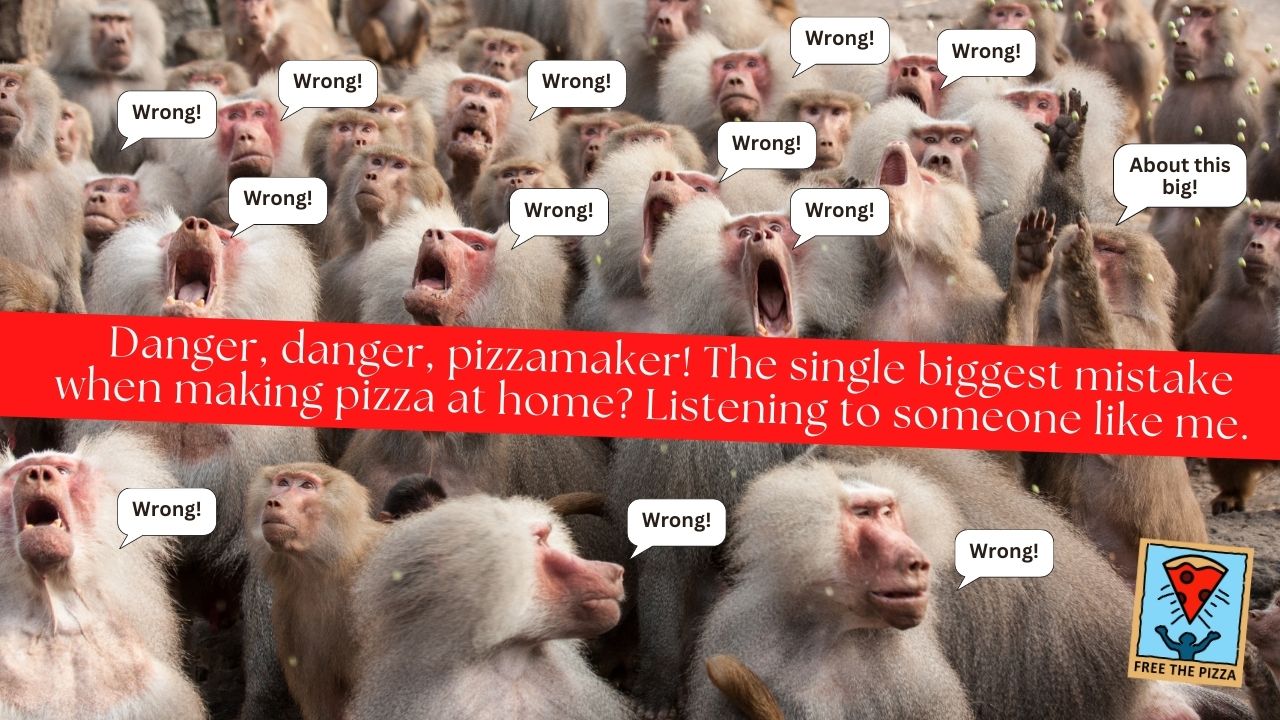|
“No self-respecting Neapolitan pizzaiolo would ever do it that way.” “Pizza sauce should NEVER be cooked!” “Use parchment paper!” Here’s a word of advice: Be wary of any advice you get from the Toxic Global Opinionsphere of PizzaNet. Why should you take my advice on that? Maybe you shouldn’t. Just because I’ve written an award-winning, #1 bestselling book on pizza making and it’s available at Amazon, it doesn’t mean I actually know anything about making pizza. (It’s true. The first two sentences of the book are, “I am not a professional chef. I don’t know what I’m talking about.”) Welcome to simple truths about life in the digital age! Any know-it-all can have a platform—and often does. And that platform is often used by people with enough knowledge to be dangerous. That might even mean me.
As one of my own fans said in his reader review of Free The Pizza!, “Online searches reveal mountains of bad pizza systems, contradictory advice, and pretentious posturing.” That is a succinct statement of the problem. I could now say, “Believe nothing you read online” and you can stop reading right here. But since I try to be thorough, I feel compelled to illustrate the problem for your use and enjoyment. And if I can provide a few ha-has, I feel as if I’ve made your day just a little better. And it will be even better when you follow it up by eating pizza. But I digress. When we’re talking about social media, we’re talking about a world full of answers to your unasked questions. For instance, I recently saw a video someone posted for a “No-knead restaurant quality pizza dough!” It was awful. Six times more yeast than is a good idea, and all kinds of bad practices. It was all enough to make me want to restyle my hair with a pizza cutter. But then the self-appointed Pizza Patroller trotted in on his Pizza Pony and said, “Stop doing this.” His was a long comment with lots of rationale (much of it good). But who asked him? One thing I try to never do is piss on somebody’s parade. You do you. I’ll do me. I’ll provide my opinion if asked. Maybe. And I’ve seen this gentleman’s unsolicited comments before. He’s a condescending purist who comes around to tell people everything they’re doing wrong. And he picks the nits. It’s crazy. Whose pizza is right, whose is not, and who is to judge? It’s all such a flour sack full of fighting pizza piglets. Pizza Social is opinionated, fun, emotional, ignorant, incomplete, misinformed, joyful, nasty, and just plain confusing. For example… “No self-respecting Neapolitan pizzaiolo would ever do it that way.” This was the comment made by one particular self-appointed Pizza Patroller. He was responding to someone who was having trouble getting the raw pizza off the peel. Someone else suggested a technique that made him unhappy. He pissed all over it and concluded with the Neapolitan pizzaiolo comment. To which I wanted to say, “So what?” It’s not about what some pro in Naples would do at his 800-degree wood-fired oven in his AVPN-sanctioned restaurant where he’s doing 600 covers a night. Some poor bastard in Biloxi with a $20 baking stone is making accidental calzones? Don’t give him a lecture on the laws of pizza snobbery. Give him a tip he can use. But there’s a subculture of people who’ve learned enough about Neapolitan pizza that they are now The Grand Authorities From The School Of You’re Doing It Wrong. By that measure, every single one of the 1,000+ pizzas I’ve made have been wrong and clearly, so are the people who’ve enjoyed them. Another example… “Pizza sauce should NEVER be cooked!” That’s from a blogger who was writing a post about pizza sauce. The blogger is not Italian. In fact, this person comes from a places legendary for its horrendous food. Yet, as a self-appointed Pizza Patroller, this blogger is riding in on a prancing pony of absolute authority. Here’s a pro tip, oh sanctimonious Pizza Patroller: One should NEVER make absolute statements! Absolute statements leave you no exit. And here’s the deal with that blogger’s saucy comment: it’s dead wrong. There are plenty of times when pizza sauce should be cooked. If you’re making true Neapolitan pizza as dictated by the gods of the Associazione Verace Pizza Napoletana, it might be correct. Yes, the AVPN standard is San Marzano tomatoes straight from the can, run through a food mill and salted. Then, they’re put cold onto a Neapolitan-style dough that gets baked in an 800-degree wood-fired oven for about a minute and a half. If done properly, the sauce cooks in the oven. But what if I’m an American making an American-style pizza? Personally, I usually make a pizza that would be called neo-Neapolitan, or NEOpolitan, or artisan (which is pretentious, as I’m far from being an artisan), or my preferred term for my pizza, which is “mongrel.” (Woof!) Whatever you call it, my pizza gets baked in a 550-degree home oven. If you put a watery, uncooked tomato sauce onto a pizza baking at 550 degrees, you get a wet, soupy pizza. As it happens, I also make a lot of New York-style pizza. Often, standard recipes for New York-style pizza sauce start with tomato puree. You know what tomato puree is? It’s a COOKED and strained tomato product. (I don’t use puree in my sauce.) You want a professional authority’s idea on pizza sauce? No less an authoritative website than Serious Eats (which is SERIOUS about this stuff—it’s in the name!) offers a New York-style pizza sauce created by J. Kenji Lopez-Alt. This man is a geek’s geek when it comes to this stuff. His recipe includes using whole canned tomatoes (just like a Neapolitan-style sauce would), then “cook, stirring occasionally, until reduced by half, about 1 hour.” [Emphasis added.] Well, that’s an authority with a different take. Reduced by 50%? That flies in the face of “NEVER be cooked.” Who is J. Kenji Lopez-Alt anyway? Well, besides being an MIT graduate and restaurateur, he’s a writer. His first cookbook is called The Food Lab: Better Home Cooking Through Science. It was a New York Times Bestseller and won a James Beard award. But he probably doesn’t know what he’s talking about. Pizza sauce should NEVER be cooked, right? He'd probably read my silly little book and shake his head. But he is unlikely to argue with my recommendation to cook the sauce. (And since I’ve recommended never saying “never,” I had to go back and check the manuscript for Free The Pizza! Over 32,000 words, “never” appears over two-dozen times. It’s used mainly in regard to things I’ve “never” done, things that have “never” happened, things I’ve “never” expected, and never once in judgment about things that a pizzamaker should never do. Phew.) If you’re going to seek answers from an online authority, try to vet the authority. Check out credentials and other posts. See if this is someone who’s got some cred and is trustworthy. If there are any absolute statements like “Pizza sauce should NEVER be cooked,” take it in stride. If you’re going to ask for advice in Pizza Social, be wary. Approach sweeping statements with caution. Same with uninformed answers. If someone doesn’t ask probing questions, there’s a good chance the answer is suspect. If I give advice in Pizza Social, I start by asking questions. It’s almost impossible to offer someone a smart course of action if you don’t know what they’re trying to do, how they’re doing it, and what tools and recipes they’re using. The net result is my comments in Pizza Social are often much, much longer than others. But they’re generally more useful. Example: “How long can I leave the pizza on the peel?” I can say, “You’ve typically got about 10 minutes on the peel before the dough sticks.” But that’s under ideal circumstances on a wooden peel dusted with semolina. If it’s a perforated metal peel with no dusting at all, 10 minutes means an accidental calzone alert. And sometimes, the advice from Pizza Social is simply dangerous. Example: “Use parchment paper!” This is what I call the fear-based training wheels of pizza making. People are afraid they can’t launch a pizza, so they put the pizza on parchment paper to feel more comfortable about getting the pizza in the oven. Did you ever read Ray Bradbury’s Fahrenheit 451? It’s a dystopian science fiction novel about a book-burning society. The 451 refers to the temperature at which paper bursts into flames. A whole lot of pizza is baked on a steel at 550 degrees, and is often baked beneath the broiler on high. In my oven, when my steel preheats for an hour at 550, it reaches 619 degrees. With the broiler on, a sheet of parchment paper under a pizza would likely burst into flames. Hello Fahrenheit 451, Pizza Cookbook Edition. I don’t recommend parchment paper for pizza. Anyone who has a basic understand of the process and who possesses a modicum of coordination can launch a pizza. It’s easy. Paper not required. Fear is the enemy. Bottom line: pick and choose your pundits. Take the information that seems to make sense and leave the rest. If someone’s absolute ideas prove to be not so absolute, well, welcome to pizza. It is what you make it not, not what ignorance or snobbery tells you it has to be. Free the pizza! Want more questionable advice on making pizza? The silly little homemade pizza guide, Free The Pizza! (A Simple System For Making Great Pizza Whenever You Want With The Oven You Already Have), is ready and waiting to lead you astray.
0 Comments
Leave a Reply. |
AuthorBlaine Parker is the award-winning author of the bestselling, unusual and amusing how-to pizza book, Free The Pizza. Also known as The Pizza Geek and "Hey, Pizza Man!", Blaine is fanatical about the idea that true, pro-quality pizza can be made at home. His home. Your home. Anyone's home. After 20 years of honing his craft and making pizza in standard consumer ovens across the nation, he's sharing what he's learned with home cooks like you. Are you ready to pizza? Archives
July 2024
Categories
All
|
© Copyright 2021, 2022, 2023, 2024. All rights reserved.
As a ShareASale Affiliate and an Amazon Associate, we earn a small percentage from qualifying Amazon purchases at no additional cost to you.
When you click those links to Amazon (and a few other sites we work with), and you buy something, you are helping this website stay afloat, and you're helping us have many more glorious photographs of impressive pizza.
When you click those links to Amazon (and a few other sites we work with), and you buy something, you are helping this website stay afloat, and you're helping us have many more glorious photographs of impressive pizza.


 RSS Feed
RSS Feed